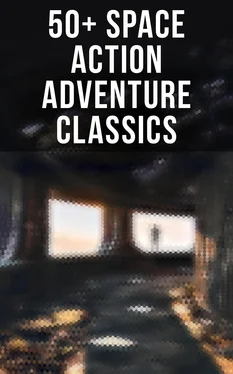None of these experts seems to have been more than mediocre; it was an age of mental and moral mediocrities; and even within the accepted limitation we have already noted, none of them seems to have worked out the New Warfare as a whole complete process. Groups of men working in secrecy, immune from outer criticism, naturally conspire not only against the foreigner but against each other, and most of the men in decisive positions were rather men skilled in securing appointments and promotion than inspired specialists. A certain lumbering quality in their devices ensued.
In Great Britain a group of these experts became exceedingly busy in what was called mechanical warfare. The British had first invented, and then made a great mess of, the tank in the World War, and they were a tenacious people. The authorities stuck to it belatedly but doggedly. In a time of deepening and ever bitterer parsimony their War Office spared no expense in this department. It was the last of all to feel the pinch. The funny land ironclads of all sizes these military “inventors” produced, from a sort of armoured machine-gunner on caterpillar wheels up to very considerable mobile forts, are still among the queerest objects in the sheds of the vast war dumps which constitute the Aldershot Museum. They are fit peers for Admiral Fisher’s equally belated oil Dreadnoughts.
The British dream of the next definitive war seems to have involved a torrent of this ironmongery tearing triumphantly across Europe. In some magic way (too laborious to think out) these armoured Wurms were to escape traps, gas poison belts, mines and gunfire. There were even “tanks” that were intended to go under water, and some that could float. Hansen even declared (see The Last War Preparations, xxiv, 1076) that he had found (rejected) plans of tanks to fly and burrow. Most of these contrivances never went into action. That throws a flavour of genial absurdity over this particular collection that is sadly lacking from most war museums.
The British and the French experts, and presently the Germans, also worked very hard at the fighting aeroplane — the British and Germans with the greatest success; the aerial torpedo, controllable at immense distances, was perfected almost simultaneously by the Italians and the Japanese. The French mind, for all its native brilliance, was hampered by its characteristic reluctance to scrap old plant for new. It was the German, American and Russian experts who went furthest with the possibilities of chemical attack. The disarmament of Germany necessarily forced its military authorities to concentrate on an arm that could be studied, experimented upon and prepared unknown to the outer world, and the Russians were forced to take up parallel enquiries because of their relative industrial poverty. The Germans had been first to use gas in the Great War, and they remained for a long time the war gas pioneers. But after the Great War much attention was given to this arm in America through the influence of the chemical industry. Biological warfare, that is to say the distribution of infectious diseases, was also extensively studied, America and the Central Europeans in this case leading the way.
Even before the Central European fighting in 1940 and the subsequent years, the distribution of various disease germs was no longer a merely theoretical possibility. Little containers, made to look like fountain pens, were already being manufactured. The caps could be removed to expose soluble ends, and then they could be dropped into reservoirs or running streams. Glass bombs also existed for use from aeroplanes, railway-train windows and so forth, which would break on hitting water. There are specimens in the Aldershot Museum. The enrolment and territorial organization of medical men and trained assistants to inoculate threatened populations went on with increasing vigour after 1932.
But there was a certain hesitation about the use of disease germs. It is easy to distribute them but hard to limit their field of action, and if prisoners (military or civilian) were still to be taken and towns and territory occupied, a well launched pestilence might conceivably recoil with deadly effect upon its users. Bacterial warfare seemed, even to the specialists who studied it, a very improbable method for any but an heroically vindictive population in the hour of defeat. Nevertheless it was thought best to have it worked out. Except for the distribution of malignant influenza in Kan-su and Shensi by the Japanese during their efforts to tranquillize North China in 1936, “without proceeding to extremities”, its use was never officially admitted. Other alleged instances of its deliberate employment by responsible Powers have been shown by the researches of the Historical Bureau to have been due either to the unauthorized zeal of subordinates or to the activities of those religious fanatics who became so prevalent during the period of confusion after 1945. The acclimatization of the mosquito transmitting yellow fever in India in 1950, which did so much to diminish the population of that peninsula, has never been explained. It is generally supposed to have been accidental.
So far as method and invention went, what was called “Gas Warfare” ran very parallel to bacterial warfare. Its beginning and end is now a closed chapter in the history of the human intelligence and will. It is surely one of the strangest. It set its stamp upon the clothing and urban architecture of the age. It ranks in horror with the story of judicial torture or the story of ritual cannibalism, but its inhumanity is more striking because of its nearness to our own times. Like those older instances, it brings home to us the supreme need for sound common general ideas to hold together human activities. It tells how thousands of clear and active minds, each indisputably sane, could, in an atmosphere obsessed by plausible false assumptions about patriotic duty and honour, cooperate to produce a combined result fantastically futile and cruel.
The people engaged in this business were, on the whole, exceptionally grave, industrious and alert-minded. Could they revisit the world to-day individually we should probably find them all respectable, companionable, intelligible persons. Yet in the aggregate they amounted to an organization of dangerous lunatics. They inflicted dreadful deaths, hideous sufferings or tormented lives upon, it is estimated, about a million of their fellow creatures.
Most of the lethal substances prepared for gas warfare purposes have passed altogether out of general knowledge. They are either never manufactured now or they are produced upon rare occasions and under proper control for the purposes of physiological research. The old devices and appliances for their distribution seem, nowadays, like grotesque anticipations of many of the features of the large scale agricultural and hygienic operations that are carried out to-day. The treatment of locust swarms by air attack, the spraying of the reafforested regions against various tree diseases, the regular cleansing and stimulation of our grain and root crops are all subsequent rationalizations of these practices of the Age of Frustration.
Faber, that Calvinistic optimist, with his doctrine that the bad is all to the good in this maddest of all conceivable worlds, thinks that all these big scale methods were “enormously stimulated” by the crazy inventiveness of the war period. But then he has also suggested that the aeroplane would not have come into general use for many years without war stimulation. We venture to think he carries his doctrine of the attainment of wisdom through imbecility too far. It is really only a modernization of Charles Lamb’s story of the invention of the roast pig. It had the touch of Rasputinism, this revival of the ancient heresy that one must sin THOROUGHLY before one can be saved.
Читать дальше











